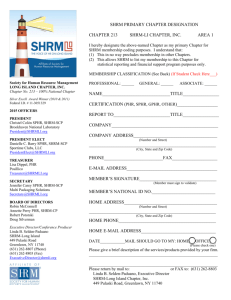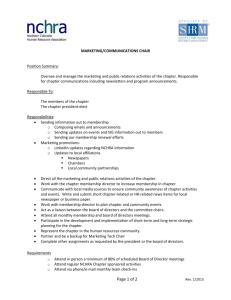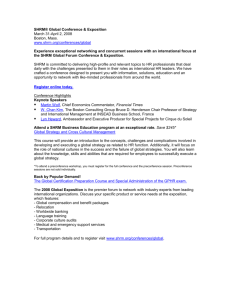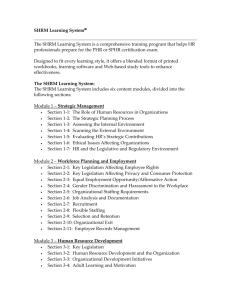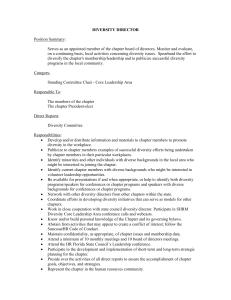Printable version
advertisement
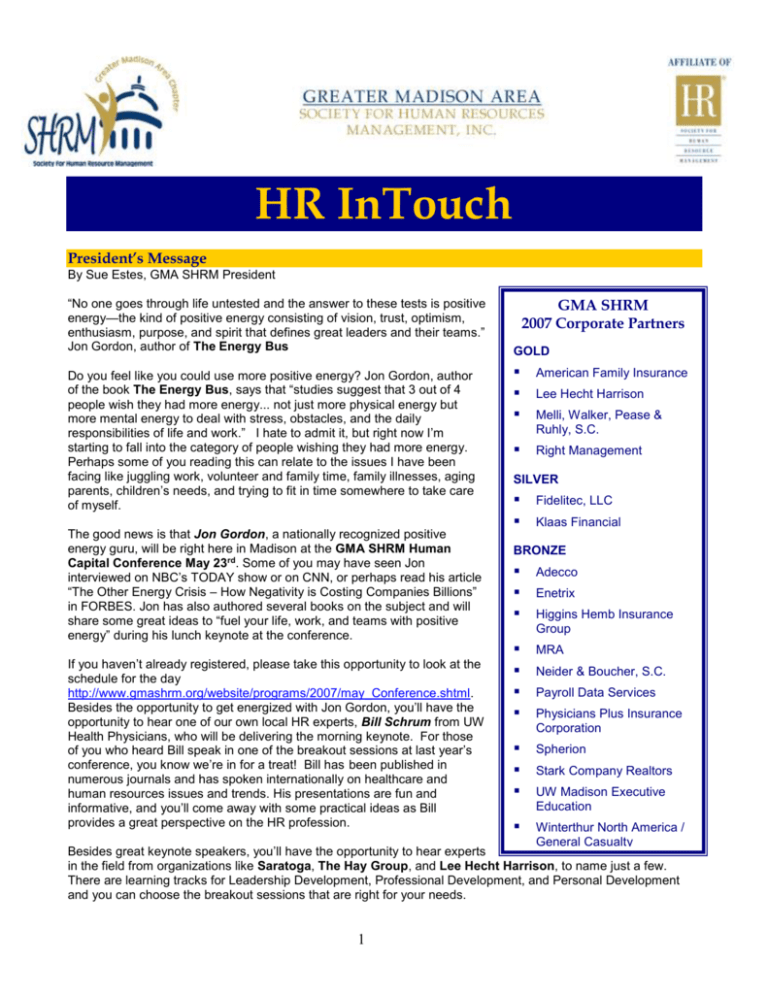
HR InTouch President’s Message By Sue Estes, GMA SHRM President “No one goes through life untested and the answer to these tests is positive energy—the kind of positive energy consisting of vision, trust, optimism, enthusiasm, purpose, and spirit that defines great leaders and their teams.” Jon Gordon, author of The Energy Bus Do you feel like you could use more positive energy? Jon Gordon, author of the book The Energy Bus, says that “studies suggest that 3 out of 4 people wish they had more energy... not just more physical energy but more mental energy to deal with stress, obstacles, and the daily responsibilities of life and work.” I hate to admit it, but right now I’m starting to fall into the category of people wishing they had more energy. Perhaps some of you reading this can relate to the issues I have been facing like juggling work, volunteer and family time, family illnesses, aging parents, children’s needs, and trying to fit in time somewhere to take care of myself. The good news is that Jon Gordon, a nationally recognized positive energy guru, will be right here in Madison at the GMA SHRM Human Capital Conference May 23rd. Some of you may have seen Jon interviewed on NBC’s TODAY show or on CNN, or perhaps read his article “The Other Energy Crisis – How Negativity is Costing Companies Billions” in FORBES. Jon has also authored several books on the subject and will share some great ideas to “fuel your life, work, and teams with positive energy” during his lunch keynote at the conference. If you haven’t already registered, please take this opportunity to look at the schedule for the day http://www.gmashrm.org/website/programs/2007/may_Conference.shtml. Besides the opportunity to get energized with Jon Gordon, you’ll have the opportunity to hear one of our own local HR experts, Bill Schrum from UW Health Physicians, who will be delivering the morning keynote. For those of you who heard Bill speak in one of the breakout sessions at last year’s conference, you know we’re in for a treat! Bill has been published in numerous journals and has spoken internationally on healthcare and human resources issues and trends. His presentations are fun and informative, and you’ll come away with some practical ideas as Bill provides a great perspective on the HR profession. GMA SHRM 2007 Corporate Partners GOLD American Family Insurance Right Management Lee Hecht Harrison Melli, Walker, Pease & Ruhly, S.C. SILVER Fidelitec, LLC Klaas Financial BRONZE Adecco MRA Spherion Winterthur North America / General Casualty Enetrix Higgins Hemb Insurance Group Neider & Boucher, S.C. Payroll Data Services Physicians Plus Insurance Corporation Stark Company Realtors UW Madison Executive Education Besides great keynote speakers, you’ll have the opportunity to hear experts in the field from organizations like Saratoga, The Hay Group, and Lee Hecht Harrison, toThank name you! just a few. There are learning tracks for Leadership Development, Professional Development, and Personal Development and you can choose the breakout sessions that are right for your needs. 1 At the end of the day of learning at the conference, you’ll have the opportunity to network with others in the profession at our special 50th Anniversary Networking Event. I hope that you’ll make time to stay for some food, fun, and fellowship. When I read the tips Jon Gordon shares about simple changes that can energize your life, I noticed that there were a few that could be accomplished during this part of our program. Jon says that you should surround yourself with positive and supportive people and to do one thing special for yourself every day. So treat yourself, stay for the networking event and meet up with some great people who could just be those positive and supportive folks you might need in your life! And now, in a tradition started earlier this year as we began celebrating our 50 th year as GMA SHRM, here is a “blast from the past”. Looking back to the April 1, 1957, TIME magazine archives is an article about recruitment titled “Spring Wooing”. http://www.time.com/time/magazine/article/0,9171,867605,00.html What I found particularly interesting was the last paragraph (and I don’t mean the comment about “hiring and training a new man”, that comment is expected from that era). What struck me was the last sentence which reads: “Said a young electrical engineer: ‘What I'd like to see them do is to spend more time interviewing the people who are leaving than worrying about hiring new people.’" Interesting how timeless the need is for exit interviews and retention strategies, isn’t it? Have a great month of May and I hope to see many of you at the Human Capital Conference on May 23 rd! Sue Estes Legal Updates “I’ve got free speech rights. You can’t discipline me.” By David R. Friedman, Friedman Law Firm Here’s a yes or no question. Does an employee have the right of free speech in the work place? For those in the pubic sector the answer is a qualified yes. For those in the private sector the answer is no. Did you answer correctly? If not, don’t be too harsh on yourself. The law on 1st Amendment rights is complex, nuanced, and a law professor’s dream. As a society we prize the right of free speech and we tend to forget that the 1 st Amendment to the United States Constitution only applies to governmental entities. In that situation, the employer is also considered to be the government and thus governed by the 1st Amendment. Last summer the U.S. Supreme Court modified the law making it harder for governmental employees to claim their free speech rights were violated when they are disciplined for “job related” speech. An abbreviated summary of the court’s decision is that “when public employees make statements pursuant to their official duties, the employees are not speaking as citizens for First Amendment purposes, and the Constitution does not insulate their communications from employer discipline.” Prior to this case, public employees were better able to make the claim that when they criticized their employer on matters of public concern they were speaking as citizens and not as employees. This approach allowed them to claim 1st Amendment free speech protection as a response to a disciplinary action. Private sector employees may think they have a similar right to criticize their employer, but generally they are wrong. A company has a right to discipline an employee that criticizes the company or other speech although the company’s right to do so is not absolute. The employee may try to claim the right of free speech where the employer has disciplined the employee for speaking about the company in a manner that the employer finds to be disloyal, harmful to business, disruptive of the work place or a challenge to the company’s operation. The employee’s speech might originate by an email, a written petition to the boss, comments on a blog or other forms of communication. 2 It is clear that when the speech takes place at work on work time, the employer’s right to discipline the employee is the strongest. The employer’s ability to discipline the employee starts to weaken when the comments are made off duty and away from the employer’s property. But even in those situations where the employer’s ability to discipline might appear to be the strongest, some other laws might protect the employee’s right to speak. The most obvious is the whistle blower laws. If the employee’s speech is covered by such a law, the fact that the 1st Amendment doesn’t apply is irrelevant. Another example is where an employee complains that the employer violated Title VII. The employer has to be careful not to discipline an employee for filing a charge of discrimination, participating in an EEOC investigation, or opposing discriminatory practices. A third, but not the last, example is the National Labor Relations Act’s provision regarding employees who engage in protected concerted activity. This portion of the law applies even if your company is non-union. It means that if two or more employees bring a work related complaint to the employer, the employer may not be able to discipline the employees for their action. So the next time you are asked about an employee’s right to speak out at work, you can answer - - it depends. The opinions expressed or implied are those of the author and may not represent the official position of GMASHRM. This article is intended for general information purposes and highlights developments in the legal area. This article does not constitute legal advice. The reader should consult legal counsel to determine how this information applies to any specific situation Compensation and Benefits The New Rules for Deferred Compensation Plans By Adam Jensen, JD, CEBS, FLMI, Virchow Krause Employee Benefits Although the Internal Revenue Service (IRS) has again postponed the implementation date for the deferred compensation rules created by Internal Revenue Code (IRC) §409A, employers with non-qualified deferred compensation (NQDC) plans still need to review their existing plans. New Effective Date IRS Notice 2006-79 postponed the regulatory effective date for the §409A regulations from January 1, 2007, to January 1, 2008. The IRS has also pushed back the requirement that was added by §409A that nontaxable deferrals be reported annually on Forms W2. Although the final implementation date has been delayed until 2008, plans must operate in good faith compliance in the meantime. Changes Under the New Rules The American Jobs Creation Act of 2004 created a new set of regulations that established constructive receipt guidelines for NQDC plans. The new constructive receipt rules limit the circumstances under which nonqualified deferred compensation can be distributed and regulate the timing of deferral and payout elections of participants. The §409A rules broaden the definition of "nonqualified deferred compensation" to include any agreement or arrangement (including those covering only one person) that provides for the deferral of compensation, including many of the split-dollar insurance programs used by employers to fund executive retirement obligations and certain executive retiree medical plans. Specifically exempted from the regulations were certain tax-favored retirement plans, bona fide vacation leave, sick leave, compensatory time, disability pay, and death benefit plans. Grandfathered Plans The new rules apply to amounts deferred in taxable years beginning after December 31, 2004. Amounts deferred in taxable years beginning before January 1, 2005, were “grandfathered,” and the new rules do not apply to them, unless the plan under which such deferrals were made is materially modified after October 3, 2004. An amount is considered deferred before January 1, 2005, if the amount is earned and vested before that date. The addition of any benefit, right or feature is a material modification. Limitations on Distributions 3 Under the new rules, an NQDC plan may not allow distributions to be made other than upon: (1) a separation from service; (2) death; (3) a fixed schedule or specified time; (4) disability; (5) a change in control of the corporation; or (6) an unforeseeable emergency. Distributions to “key employees” of public companies cannot be made until at least 6 months after the separation date. Acceleration of distributions of deferred compensation is not permitted. Once popular “haircut” acceleration provisions, that permit a participant to receive immediate payment of deferred compensation subject to a penalty forfeiture of a percentage (often 10%) of the deferred compensation otherwise payable, will no longer be permitted. Changes to Time and Form of Distribution Restricted Rules governing deferral elections, time and form of distribution, and subsequent elections to delay payment have been formalized. Participants must elect to defer compensation by the end of the preceding taxable year, for example, deferrals for the 2008 tax year must be elected by the end of 2007. The §409A rules specify that the time and form of distribution must be specified at the time the deferral is elected. Participants may elect to delay payouts or change the form of payment under the new rules, subject to certain restrictions. New Funding Prohibitions Under the new rules, if assets were set aside offshore (outside the US), in a trust or otherwise, the assets will be treated as immediately taxable transfers of property to the plan participants. Although Rabbi trusts are still generally allowed under the Act (including so-called “springing” Rabbi trusts that are not funded until the occurrence of a specified event), springing Rabbi trusts that are triggered by adverse changes in employer financial health are specifically prohibited. In the past, employers attempted to provide increased financial security to plan participants by restricting payment of deferred compensation plan assets to plan participants in the event of an adverse change in the employer’s financial health. Under the Act, the mere presence of financial health triggers in a plan will result in plan assets and any subsequent gains to be characterized immediately as taxable property transfers to the plan participants. However, a springing Rabbi trust that is not funded unless there was a “change of control” of the employer would be permitted under §409A. Penalties Failure to comply with the new requirements can result in constructive receipt of plan deferrals and associated gains to plan participants. In addition to the burden of immediate taxation, interest and a 20% penalty could be assessed on the amounts constructively received. Adam P. Jensen is a Senior Consultant with Virchow Krause Employee Benefits, LLC and has worked in the insurance and employee benefits industry since 1986. Adam specializes in providing regulatory compliance and plan design services for health and welfare plans and qualified retirement plans. He also advises executive clients on non-qualified deferred compensation issues. Diversity New Freedom Initiative Award The Secretary of Labor’s New Freedom Initiative Award annually recognizes non-profits, small businesses, corporations and individuals that have demonstrated exemplary and innovative efforts in furthering the employment and workplace environment for people with disabilities. The Office of Disability Employment Policy at the U.S. Department of Labor administers the award program and has extended the nomination deadline for 2007 to May 31st. If you are interested in learning about the program, click here for a list of past years’ recipients and further information. Employee Relations Metrics and Tools Pending State Legislation As HR professionals, it is important that we remain updated on legislation affecting our daily practices and workplace policies and procedures, whether we take an active role in shaping the legislation or simply want to be prepared when a new piece of legislation takes effect. Fortunately, the national SHRM organization makes it easy with a Pending Legislative Report for each state. The report will tell you the type of legislation (Wage and 4 Hour, Employment Discrimination, Mandated Benefits, etc.) and will provide a summary and the bill sponsor. The main web page for the Pending Legislative Report will also provide you with a link to send an email to your state representative, if you wish to contact him or her about the pending legislation. Career Development Talent Management What Makes the Most Admired Companies Great? On Wednesday, May 23rd, GMA SHRM invites you to the Human Capital Conference: Investing in You, Investing in the Profession. The GMA SHRM Programming Committee has designed an outstanding program of keynote and breakout session speakers encompassing the Leadership, Professional, and Personal Development track areas. Mark Royal, a Senior Consultant with Hay Group Insight, Hay Group’s employee and customer research division, will be presenting a leadership development track breakout session titled: What Makes the Most Admired Companies Great. The Hay Group has partnered with Fortune magazine since 1997 to identify the World’s and America’s Most Admired Companies. Mark plays a leading role in directing this annual research and uncovering the business practices that make these companies highly regarded and highly successful. This research suggests that Most Admired Companies display distinctive approaches to: Attraction and Retention of Talent: Most Admired Companies display rigorous selection procedures for evaluating potential hires, a strong emphasis on providing growth and development opportunities for employees, and a commitment to tying pay and promotions to performance. Organizational Culture: Most Admired Companies emphasize fostering innovation over minimizing risk and customer focus over respecting the chain of command. Leadership Development: In Most Admired Companies, leadership development involves disciplined candidate identification and selection processes, training programs that are clearly linked to organizational objectives, and leadership models that emphasize social and emotional skills as well as technical skills. Performance Management: Most Admired Companies set challenging goals for executives, closely tie executive compensation to goal achievement, and encourage executives to focus on long-term as well as short-term objectives. Strategy Implementation: In Most Admired Companies, greater clarity regarding strategic objectives can be found at all levels, performance measures are more closely aligned with strategies, and executives are held more accountable for carrying out strategic plans. Responding to Economic Uncertainty: Most Admired Companies distinguish themselves from peers in tough economic times in many of the same ways they distinguish themselves from peers in good economic times Success in Execution: The success of Most Admired Companies in execution, results from high degrees of alignment in roles and responsibilities, clarifying decision making processes, investing in the development of talent, and continuously managing performance to ensure that people follow through on commitments and objectives. Fostering Innovation: The most innovative companies are distinguished by leaders who provide clear direction for innovative activity, organizational climates and cultures that support the development of new ideas and the combination of existing ideas in novel ways, and focused management of investments in innovation to ensure effective implementation. 5 Leading the Global Organization: companies highly regarded for global success don't merely operate internationally, they function as true global companies. They coordinate activities across a dispersed organization by aligning business units and subsidiaries around a common strategic vision and corporate culture. Technology in HR Learning and Development Recruitment and Staffing Should Turnover Be on Your Dashboard? by Mary Hunter, SPHR, Senior HR Director, MRA When asked to select the two metrics respondents deemed most important to their organization’s management from a list of 14, retention/turnover was in the top five with 25.3 percent of respondents making this selection (2004 Global Learning Resources Recruiting Trends Survey Report). Jack Phillips, author of Accountability in Human Resource Management, also places turnover in the five key measures to analyze the return on HR’s efforts. When MRA’s HR program attendees are asked about what they measure, turnover almost always comes up as number one. What is the value in measuring turnover? Turnover is generally defined as the number of terminations divided by the average number of employees over a given time period. Turnover could be reported monthly, quarterly, annually, or an organization could use a rolling number (last three months, last 12 months, for example). Frequently HR professionals ask what is the “right” turnover and there is no generic answer to this question. Turnover should be viewed in relation to an organization’s environment. Labor shortages, economic factors, management changes, and cultural changes can all impact turnover. Low turnover, viewed in a vacuum, might just be the result of a poor economy rather than anything a company is doing or not doing. Turnover is primarily an indicator. Increasing turnover could be an indicator of a human capital issue that needs to be addressed. Turnover that is high relative to similar industries in similar regions may signal the existence of one or more problems. While turnover can be helpful in identifying trends in an organization, solely measuring overall employee turnover is probably not sufficient. It might be more helpful to measure targeted turnover numbers, which can pinpoint success of HR programs or retention issues that may need to be addressed. To that end, the following turnover measurements might be worthy of a spot on that dashboard: Turnover rate of new hires in the last 12 months. Voluntary versus involuntary turnover. Turnover of diversity hires or employees compared to general turnover. Performance turnover in key jobs (this would require the assignment of greater weight to a top performer who leaves the organization than to an average performer). Turnover in key areas expected to be critical to business success in the next three years. What turnover metric an organization selects will depend on its relationship to the organizations’ strategic objectives. If an organization has identified retention of all or certain employees as a key initiative, some measurement of retention/turnover can be very helpful in an organization. Perhaps the organization has as a goal to drive turnover from “x” to “y.” The dashboard could measure the progress in reaching the goal as well as report the current turnover. Or an organization may want to take it one step further and put together a cost figure that can be associated with turnover. For example, once turnover has been assigned a cost, the total cost of each tenth of a point change in turnover could be calculated and placed on the dashboard. This would help to emphasize financial impact or turnover. Turnover/retention metrics may be just the tool an HR department needs to help report the impact of initiatives to the organization. The specific turnover measurements used will be selected based on the organization’s goals. 6 Mary Hunter is Senior HR Director with MRA. She has over 20 years of experience in all facets of human resources management. Mary spent over eight years in the Human Resource Professional Program at MRA and now responds to member inquiries in HR Information & Solutions. While working as a broad-based generalist, Mary also has particular expertise in the areas of benefits, absence control, FMLA, COBRA, and drug and alcohol issues. She is also certified in HR Metrics. Phone: 800.488.4845 Web: www.mranet.org SHRM News / Announcements 50th Anniversary Thoughts and Memories Past President Reflections – Stephanie A. Barganz, CPA, SPHR GMA SHRM was a wonderful resource for me to obtain a peer group in my profession. It allowed me to go to trainings that I would have never been exposed to. I was able to participate in many discussions regarding best practices across several represented industries. As a leader I was consistently challenged in our approach to meet members’ needs and listen to a variety of perspectives. GMA SHRM helped me grow as a person and an individual. What is more amazing is that the impact still remains as some of the contacts I made over 10 years ago have become dear friends and/or colleagues. The Human Resource profession has gone through tremendous changes and evolutions during the last decade. I cannot imagine going through it without the resource we have in SHRM. I am grateful to all the present and past leaders of this organization - Keep up the great work! Welcome New Members! GMA SHRM welcomes the following members who joined our chapter in March. Lisa Chupak, SPHR Susan M. DeCoster Melissa S. Dubois Jackie R. Falch Brittany R. Hoffman Terri Jarosinski Shelley M. Kemp Renee L. Kennedy Beth T. Long Crystal L. Porter Julie A. Riddler Jennifer M. Salvo Oscar O. Sanchez Heather Stark Jackie L. Steffens Ellen J. Stiner Human Resources Manager HR Generalist Recruiting Coordinator Employee Relations Manager HR Coordinator Human Resource Generalist Trane Madison/Milwaukee Oakwood Village Virchow Krause Requirements Quest The Swiss Colony Sonic Foundry Benefits Coordinator HR Coordinator Staffing Specialist Director, Academy Technical Recruiter Branch Team Leader Associate Relations Representative Senior HR Representative Office Manager Webcrafters, Inc. National Guardian Life ThermoFisher Scientific UW Hospitals and Clinics Compuware Corporation Remedy Intelligent Staffing US Cellular John Deere Engineering Industries, Inc. Congratulations Newly Certified Members! Please join the chapter in congratulating the following GMA SHRM members who earned their certification during the December/January exam period. Great job! Alison W. O'Connell PHR Cynthia R. Prest PHR Dena M. Gullickson, SPHR Erin Pinnow PHR Gao X. Moua PHR Holly C. Thompson, SPHR Human Resources Assistant HR Representative Human Resources Manager Recruiter Sr. HR Rep Human Resources Associate II 7 Berbee Information Networks TDS Corporate Stevens Construction Corp. Spectrum Brands Fiskars Brands, Inc. American Red Cross Blood Services Karin Cretney PHR Michelle C. Jetzer, PHR Rachelle D. Hady PHR Vickie L. Laughren PHR Sr. HR Analyst Consultant Benefits Specialist Director of Human Resources First Business Financial Services, Inc. Solaris Management LLC Sun Prairie Area School District DeForest Area School District SHRM’s Sons and Daughters Scholarship Program The national SHRM organization annually awards twenty-four scholarships of $1,500 each to help finance higher education for the children of SHRM members. Each award is for either the first or second year of study at a fouryear college or university. The application deadline is May 15, 2007. More information, including the scholarship application form, is available on the SHRM website at http://www.shrm.org/sons&daughters/ . Regional Scholarships The SHRM Foundation has doubled its scholarship funding and will be awarding a total of $100,000 to SHRM members, chapters and state councils. $50,000 in scholarships was awarded in 2006. Applications are now being accepted for the following scholarships. Deadline to apply: July 16, 2007. 60 Certification Scholarships of $750 each 40 Academic Scholarships of $1375 each The scholarships are awarded through the local SHRM regions. Applications will be judged in the following five groups: Northeast Region Southeast Region (and former Caribbean Atlantic Region) North Central Region Southwest Central Region Pacific West Region (and former Asia Pacific Region) Each group has a total of $20,000 to distribute in scholarships annually which guarantees that there will be scholarship winners in every region. Twelve certification scholarships of $750 each and eight academic scholarships of $1375 each will be presented in each group. All national SHRM members pursuing a college degree in human resources or working towards SPHR, GPHR or PHR certification are eligible to apply. (Note: SHRM professional, general or associate members may apply; however student members and local-only members of chapters are not eligible for this scholarship program.) In addition, chapters and state councils are eligible to compete for the scholarship money to fund programs that promote SPHR, GPHR or PHR certification locally. Go to http://www.shrm.org/foundation/EducationGrants.asp. Community Events 05.09.07 Wisconsin SHRM State Legislative Conference, 9am to 3pm, Boardman Law Firm, 1 S. Pinckney St., Fourth Floor. Program includes updates on national and state legislative issues. Lunch included. Last-minute registration is available by fax before noon on Monday, May 8th. Go to http://www.wishrm.org/ for a registration form. 05.11.07 “How to Find a Gratifying New Career…When You Want or Need to Make a Change”, 12 to 1pm, The Madison Club, 5 E. Wilson St. Making a career transition is a challenging task – whether it’s by choice or not. This seminar is for executives and professionals who want to take charge of their career direction. Executive career consultant Donna Beestman, President of Career Success Strategies, a firm providing executive corporate outplacement 8 and private career coaching, will discuss a proven process that works and will share tips to make effective, satisfying career moves. Phone: 608-831-5226, Web: www.careersuccessstrategies.com. Movin’ Up Have you started with a new company? Has your organization recently promoted you to a new position? Or do you want to recognize a new person or promotion within your department? If so, we want to hear about it. Send us an e-mail, and we’ll publish your good news in the next HR InTouch! HR InTouch Guidelines Article Writing: Do you have an interest in writing for the HR InTouch? We have an interest in learning more about your area of expertise! Why should you volunteer? Top three reasons: 1) to share your knowledge and experiences to educate others; 2) to become more connected in the HR and Dane County communities; and 3) to contribute towards the advancement of GMA SHRM and the HR profession. The first step is for you to choose a submission option: you can pre-submit an article to GMA SHRM at any time for us to use in any of the upcoming newsletters, you can sign up to write for a particular month, or we can put you on a list of people to contact in future months whenever we need articles. Article length: Because the HR InTouch is now in an online format, the size is flexible. The article should be engaging and hold readers’ attention. Include the core information in your article, and we will advise if it is too lengthy. Solicitation: GMA SHRM is conscious not to allow solicitation through the articles, in an effort to protect the interests of our partners and members. The nature of the article should be educational (i.e., what are the business advantages of having a product like yours) or informational. Otherwise, if you truly are interested in advertising through the HR InTouch, you can work with our Marketing Committee. As a rule of thumb for article writing, if the submission relates to a for-profit event, or specifically markets your company (vs. your industry), it is an advertisement, and should be purchased. If it is a not-for-profit event that your company is hosting, or an announcement (i.e., a SHRM member recently joined your company), it is an acceptable addition to the HR InTouch content. If you have any questions related to the appropriateness of your submission, please contact us. If you have questions, or to submit an article, contact GMA SHRM at chapteradmin@gmashrm.org. 9
